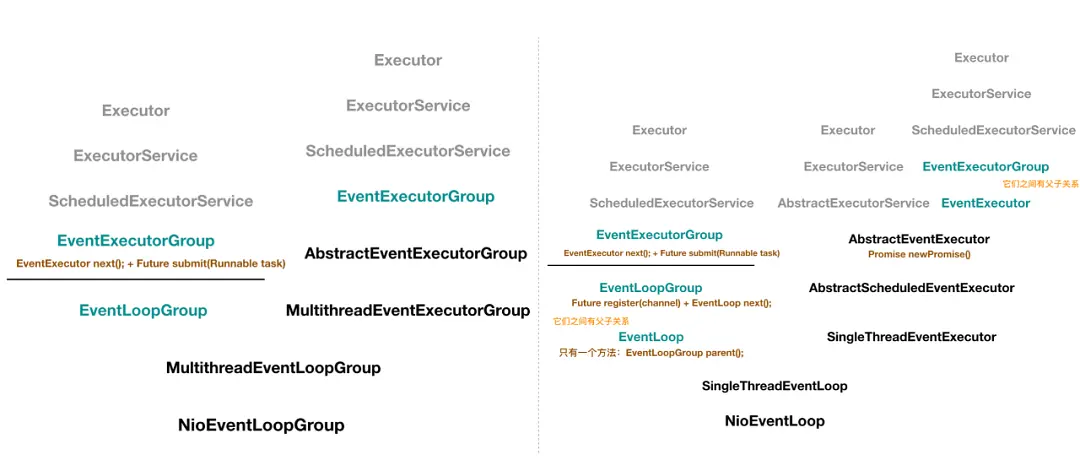Netty 源码解析(五): Netty 的线程池分析


今天是猿灯塔“365 篇原创计划”第五篇。接下来的时间灯塔君持续更新 Netty 系列一共九篇
Netty 源码解析(一): 开始
Netty 源码解析(二): Netty 的 Channel
Netty 源码解析(三): Netty 的 Future 和 Promise
Netty 源码解析(四): Netty 的 ChannelPipeline
当前:Netty 源码解析(五): Netty 的线程池分析
Netty 源码解析(六): Channel 的 register 操作
Netty 源码解析(七): NioEventLoop 工作流程
Netty 源码解析(八): 回到 Channel 的 register 操作
Netty 源码解析(九): connect 过程和 bind 过程分析
今天呢!灯塔君跟大家讲:
Netty 的线程池分析
Netty 中的线程池 EventLoopGroup
接下来,我们来分析 Netty 中的线程池。Netty 中的线程池比较不好理解,因为它的类比较多,而且它们之间的关系错综复杂。看下图,感受下 NioEventLoop 类和 NioEventLoopGroup 类的继承结构:

这张图我按照继承关系整理而来,大家仔细看一下就会发现,涉及到的类确实挺多的。本节来给大家理理清楚这部分内容。
首先,我们说的 Netty 的线程池,指的就是 NioEventLoopGroup 的实例;线程池中的单个线程,指的是右边 NioEventLoop 的实例。
回顾下我们第一节介绍的 Echo 例子,客户端和服务端的启动代码中,最开始我们总是先实例化 NioEventLoopGroup:
// EchoClient 代码最开始:
EventLoopGroup group = new NioEventLoopGroup();
// EchoServer 代码最开始:
EventLoopGroup bossGroup = new NioEventLoopGroup(1);
EventLoopGroup workerGroup = new NioEventLoopGroup();
下面,我们就从 NioEventLoopGroup 的源码开始进行分析。我们打开 NioEventLoopGroup 的源码,可以看到,NioEventLoopGroup 有多个构造方法用于参数设置,最简单地,我们采用无参构造函数,或仅仅设置线程数量就可以了,其他的参数采用默认值。
比如上面的代码中,我们只在实例化 bossGroup 的时候指定了参数,代表该线程池需要一个线程。
我们来稍微看一下构造方法中的各个参数:
nThreads:这个最简单,就是线程池中的线程数,也就是 NioEventLoop 的实例数量。
executor:我们知道,我们本身就是要构造一个线程池(Executor),为什么这里传一个 executor 实例呢?它其实不是给线程池用的,而是给 NioEventLoop 用的,以后再说。
chooserFactory:当我们提交一个任务到线程池的时候,线程池需要选择(choose)其中的一个线程来执行这个任务,这个就是用来实现选择策略的。
selectorProvider:这个简单,我们需要通过它来实例化 JDK 的 Selector,可以看到每个线程池都持有一个 selectorProvider 实例。
selectStrategyFactory:这个涉及到的是线程池中线程的工作流程,在介绍 NioEventLoop 的时候会说。
rejectedExecutionHandler:这个也是线程池的好朋友了,用于处理线程池中没有可用的线程来执行任务的情况。在 Netty 中稍微有一点点不一样,这个是给 NioEventLoop 实例用的,以后我们再详细介绍。
这里介绍这些参数是希望大家有个印象而已,大家发现没有,在构造 NioEventLoopGroup 实例时的好几个参数,都是用来构造 NioEventLoop 用的。下面,我们从 NioEventLoopGroup 的无参构造方法开始,跟着源码走:
然后一步步走下去,到这个构造方法:
大家自己要去跟一下源码,这样才知道中间设置了哪些默认值,下面这几个参数都被设置了默认值:
selectorProvider = SelectorProvider.provider()这个没什么好说的,调用了 JDK 提供的方法
selectStrategyFactory = DefaultSelectStrategyFactory.INSTANCE 这个涉及到的是线程在做 select 操作和执行任务过程中的策略选择问题,在介绍 NioEventLoop 的时候会用到。
rejectedExecutionHandler = RejectedExecutionHandlers.reject()大家进去看一下 reject() 方法,也就是说,Netty 选择的默认拒绝策略是:抛出异常
跟着源码走,我们会来到父类 MultithreadEventLoopGroup 的构造方法中:
这里我们发现,如果采用无参构造函数,那么到这里的时候,默认地 nThreads 会被设置为 CPU 核心数 *2。大家可以看下 DEFAULT_EVENT_LOOP_THREADS 的默认值,以及 static 代码块的设值逻辑。我们继续往下走:
到这一步的时候,new ThreadPerTaskExecutor(threadFactory) 会构造一个 executor。
我们现在还不知道这个 executor 怎么用。这里我们先看下它的源码:
publicfinalclassThreadPerTaskExecutorimplementsExecutor{privatefinalThreadFactorythreadFactory;public ThreadPerTaskExecutor(ThreadFactorythreadFactory) {if(threadFactory==null){thrownewNullPointerException("threadFactory");} this.threadFactory=threadFactory;}@Overridepublic void execute(Runnablecommand) {//为每个任务新建一个线程threadFactory.newThread(command).start();}}Executor 作为线程池的最顶层接口, 我们知道,它只有一个 execute(runnable) 方法,从上面我们可以看到,实现类 ThreadPerTaskExecutor 的逻辑就是每来一个任务,新建一个线程。我们先记住这个,前面也说了,它是给 NioEventLoop 用的,不是给 NioEventLoopGroup 用的。
.一步设置完了 executor,我们继续往下看:
ChooserFactory 的逻辑比较简单,我们看下 DefaultEventExecutorChooserFactory 的实现:
OverridepublicEventExecutorChoosernewChooser(EventExecutor[]executors) {if(isPowerOfTwo(executors.length)){ return newPowerOfTwoEventExecutorChooser(executors);}else{returnnewGenericEventExecutorChooser(executors);}}这里设置的策略也很简单:1、如果线程池的线程数量是 2^n,采用下面的方式会高效一些:@OverridepublicEventExecutornext() {returnexecutors[idx.getAndIncrement()&executors.length-1];}2、如果不是,用取模的方式:@OverridepublicEventExecutornext() {returnexecutors[Math.abs(idx.getAndIncrement()%executors.length)];}
走了这么久,我们终于到了一个干实事的构造方法中了:
上面的代码非常简单吧,没有什么需要特别说的,接下来,我们来看看 newChild() 这个方法,这个方法非常重要,它将创建线程池中的线程。
我上面已经用过很多次"线程"这个词了,它可不是 Thread 的意思,而是指池中的个体,后面我们会看到每个"线程"在什么时候会真正创建 Thread 实例。反正每个 NioEventLoop 实例内部都会有一个自己的 Thread 实例,所以把这两个概念混在一起也无所谓吧。
newChild(…) 方法在 NioEventLoopGroup 中覆写了,上面说的"线程"其实就是 NioEventLoop:
我们先粗略观察一下,然后再往下看:
在 Netty 中,NioEventLoopGroup 代表线程池,NioEventLoop 就是其中的线程。
线程池 NioEventLoopGroup 是池中的线程 NioEventLoop 的 parent,从上面的代码中的取名可以看出。
每个 NioEventLoop 都有自己的 Selector,上面的代码也反应了这一点,这和 Tomcat 中的 NIO 模型有点区别。
executor、selectStrategy 和 rejectedExecutionHandler 从 NioEventLoopGroup 中一路传到了 NioEventLoop 中。
这个时候,我们来看一下 NioEventLoop 类的属性都有哪些,我们先忽略它继承自父类的属性,单单看它自己的:
结合它的构造方法我们来总结一下:
provider:它由 NioEventLoopGroup 传进来,前面我们说了一个线程池有一个 selectorProvider,用于创建 Selector 实例
selector:虽然我们还没看创建 selector 的代码,但我们已经知道,在 Netty 中 Selector 是跟着线程池中的线程走的。也就是说,并非一个线程池一个 Selector 实例,而是线程池中每一个线程都有一个 Selector 实例。在无参构造过程中,我们发现,Netty 设置线程个数是 CPU 核心数的两倍,假设我们的机器 CPU 是 4 核,那么对应的就会有 8 个 Selector 实例。
selectStrategy:select 操作的策略,这个不急。
ioRatio:这是 IO 任务的执行时间比例,因为每个线程既有 IO 任务执行,也有非 IO 任务需要执行,所以该参数为了保证有足够时间是给 IO 的。这里也不需要急着去理解什么 IO 任务、什么非 IO 任务。
然后我们继续走它的构造方法,我们看到上面的构造方法调用了父类的构造器,它的父类是 SingleThreadEventLoop。
SingleThreadEventLoop 这个名字很诡异有没有?然后它的构造方法又调用了父类 SingleThreadEventExecutor 的构造方法:
到这里就更加诡异了,NioEventLoop 的父类是 SingleThreadEventLoop,而 SingleThreadEventLoop 的父类是 SingleThreadEventExecutor,它的名字告诉我们,它是一个 Executor,是一个线程池,而且是 Single Thread 单线程的。也就是说,线程池 NioEventLoopGroup 中的每一个线程 NioEventLoop 也可以当做一个线程池来用,只不过它只有一个线程。这种设计虽然看上去很巧妙,不过有点反人类的样子。上面这个构造函数比较简单:
设置了 parent,也就是之前创建的线程池 NioEventLoopGroup 实例
executor:它是我们之前实例化的 ThreadPerTaskExecutor,我们说过,这个东西在线程池中没有用,它是给 NioEventLoop 用的,马上我们就要看到它了。提前透露一下,它用来开启 NioEventLoop 中的线程(Thread 实例)。
taskQueue:这算是该构造方法中新的东西,它是任务队列。我们前面说过,NioEventLoop 需要负责 IO 事件和非 IO 事件,通常它都在执行 selector 的 select 方法或者正在处理 selectedKeys,如果我们要 submit 一个任务给它,任务就会被放到 taskQueue 中,等它来轮询。该队列是线程安全的 LinkedBlockingQueue,默认容量为 16。
rejectedExecutionHandler:taskQueue 的默认容量是 16,所以,如果 submit 的任务堆积了到了 16,再往里面提交任务会触发 rejectedExecutionHandler 的执行策略。
还记得默认策略吗:抛出 RejectedExecutionException 异常。在 NioEventLoopGroup 的默认构造中,它的实现是这样的:
privatestaticfinalRejectedExecutionHandlerREJECT=newRejectedExecutionHandler(){ @Override publicvoidrejected(Runnabletask,SingleThreadEventExecutorexecutor) { thrownewRejectedExecutionException();}};
然后,我们再回到 NioEventLoop 的构造方法:
可以看到,最重要的方法其实就是 openSelector() 方法,它将创建 NIO 中最重要的一个组件 Selector。在这个方法中,Netty 也做了一些优化,这部分我们就不去分析它了。到这里,我们的线程池 NioEventLoopGroup 创建完成了,并且实例化了池中的所有 NioEventLoop 实例。同时,大家应该已经看到,上面并没有真正创建 NioEventLoop 中的线程(没有创建 Thread 实例)。提前透露一下,创建线程的时机在第一个任务提交过来的时候,那么第一个任务是什么呢?是我们马上要说的 channel 的 register 操作。
365 天干货不断微信搜索「猿灯塔」第一时间阅读,回复【资料】【面试】【简历】有我准备的一线大厂面试资料和简历模板
版权声明: 本文为 InfoQ 作者【猿灯塔】的原创文章。
原文链接:【http://xie.infoq.cn/article/32cf8c6cb579112e48af1e8ca】。文章转载请联系作者。












评论